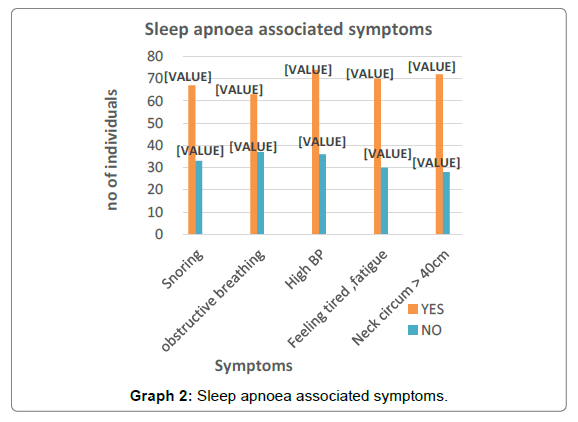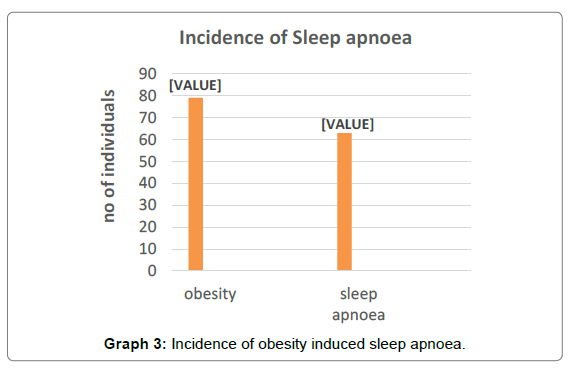Research Article Open Access
Obesity Associated Sleep Apnoea in Men
Nida Tabassum Khan*
Department of Biotechnology, Balochistan University of Information Technology Engineering and Management Sciences (BUITEMS), Quetta, Pakistan
- *Corresponding Author:
- Nida Tabassum Khan
Department of Biotechnology
Faculty of Life Sciences and Informatics
Balochistan University of Information Technology Engineering and Management Sciences,(BUITEMS)
Quetta, Pakistan
Tel: +92 3368164903
E-mail: nidatabassumkhan@yahoo.com
Received Date: August 08, 2017; Accepted Date: August 21, 2017; Published Date: August 25, 2017
Citation: Khan NT (2017) Obesity Associated Sleep Apnoea in Men. J Tradit Med Clin Natur 6:235.
Copyright: © 2017 Khan NT. This is an open-access article distributed under the terms of the Creative Commons Attribution License, which permits unrestricted use, distribution, and reproduction in any medium, provided the original author and source are credited.
Visit for more related articles at Journal of Traditional Medicine & Clinical Naturopathy
Abstract
It has been reported that individuals with a Body Mass Index (BMI) ≥30 kg/m2 suffers from obstructive sleep Apnoea. Therefore this qualitative study was conducted using a diagnostic tool called as STOP bang with sensitivity of 92.9% and 100%, for detecting incidence of sleep apnoea in individuals. Obtained result revealed that out of 79 obese male individuals, 63 were suffering from sleep apnoea indicating its high prevalence. But due the qualitative nature of this study some clinical parameters were not assessed but still on the basis of our findings we can confidently claim that incidence of sleep apnoea in obese men is high and is worthy of attention
Keywords
Obesity; Obstructive sleep apnoea; Incidence; Body Mass Index (BMI)
Introduction
According to national institutes of health and world health organization prevalence of overweight and obesity are extremely high [1] inducing obstructive sleep apnoea in individuals. It has been reported that individuals with a body mass index (BMI) ≥30 kg/m2, 60-90% of them suffers from obstructive sleep apnoea. As there is an increase in the BMI value of an individual so it will elevate the chances of sleep apnoea occurrence [2]. Sleep apnoea is more prevalent in men and mature aged individuals but might occur in children and adolescents as well [3]. It is recognized as a self-regulating risk factor for high blood pressure, cardiovascular infarctions, chest pain, angina [4] obesity, inflammation, metabolic syndrome, insulin resistance and type 2 diabetes mellitus [5,6]. Besides it has been reported that if sleep apnoea is left untreated it may cause shortening of lifespan by up to twenty years [7] with adverse health consequences such as memory loss, poor performance, an elevated risk of vehicle accidents [8,9], glucose intolerance, dyslipidemia, all of which are important risk factors for atherosclerosis [8,9]. Patients with sleep apnoea may have symptoms that occur during sleep at night e.g. loud snoring, wheezing or obstructing sensations during sleep, halted breathing during sleep, nocturia, diaphoresis and poor sleep quality. Although 95% of patients with snoring symptom at night, is not associated with sleep apnoea. However there are better chances of diagnosis of witnessed apnoeas than snoring [9]. Sleep apnoea does not only affect the metabolic functions of the body but also an individual’s quality of life. Such that he experiences poor sleep quality, night after night, resulting in a wide spectrum of daytime sleepiness, fatigue, headaches, mood swings, depression, lack of focus or concentration etc. [7,10,11]. Therefore early diagnosis of this disorder is very crucial.
Materials and Methods
Male participants included in this study belonged to the age group from 30 to 50 years, selected at random. Informed consent was taken from the participants keeping the sample size 100. This qualitative study was conducted with the help of a convenient clinical diagnostic scale called as STOP (snoring, tired, observed, pressure) Bang (BMI, age, neck circumference, and gender) employed by anesthesiologist, with a sensitivity of 92.9% and 100%, for sleep apnoea [12]. The purpose of this tool is to diagnose and determine the prevalence of obesity induced sleep apnoea in men. BMIs of the individuals were also calculated to assess the weight status of the studied individuals. So that they could be categorized were also categorized as normal, under/overweight and obese. Statistical analysis of the data was done by means of Microsoft excel.
Results
Out of 100 male participants, 79% were found to be obese while 9 % were overweight as depicted in Graph 1. Sleep apnoea associated symptoms on the basis of which individuals were diagnosed with sleep apnoea are given in Graph 2. Incidence of Sleep apnoea and its relationship with obesity is given in Graph 3.
Discussion
Studies have reported that a consistent relationship occurred between obesity and sleep apnoea [13]. As depicted by the obtained result that out of 79 obese male individuals, 63 were suffering from sleep apnoea. This high incidence of sleep apnoea in obese patients is mainly because they have clinical symptoms that are associated with this disorder. For example these effected individuals have obstructive breathing, snoring, high blood pressure and experience daytime fatigue. Similarly it was determined that a rapid increase in the weight status of an individual causes an increase in the frequency of sleep apnoea. Thus obesity and sleep apnoea exhibit a directly proportional relationship with each other [14]. The exact mechanism that how obesity induces or triggers sleep apnoea is still unidentified but do enhances the effect of sleep apnoea. As this is strengthened by the fact that patients diagnosed with sleep apnoea was found to have history of excessive weight gain [15,16]. Besides, factors such as disturbed eating patterns, smoking, high blood pressure and lack of exercise also contributes towards the establishment of obstructive sleep apnoea [17]. Therefore it could be concluded that obesity and sleep apnoea mutually enhance their progression and severity indicating a reciprocal relation between them. However there were a number of margins and constraints in this research such as high level of expertise is required by the specialists to identify the symptoms of sleep apnoea, so that the affected ones could be referred for an appropriate diagnostic test. Confirmation of sleep apnoea in patients requires reliable investigation methods such as an overnight sleep study, or Polysomnogram (PSG), monitoring airflow, breathing activity and respiratory effort, oxygen concentration, brain EEG activity, leg muscle activity, and sleeping position [18]. All these parameters should be taken in account to give an exact diagnosis of sleep apnoea. Though due to the descriptive nature of this designed study these parameters were not assessed in this study but still on the basis of our findings we can confidently claim that incidence of sleep apnoea in obese men is high and is worthy of attention.
Conclusion
Sleep apnoea is a highly dominant in male patients with obesity and if not diagnosed, it might result in serious health problems. Effective treatment is available which, when combined with control measures such as balanced dietary intake, normal blood pressure and regular exercise can significantly improve the outlook for sleep apnoea affected patients.
References
- Kuczmarski RJ, Flegal KM (2000) Criteria for definition of overweight in transition: background and recommendations for the United States. Am J Clin Nutr 72: 1074-1081.
- Romero-Corral A, Caples SM, Lopez-Jimenez F, Somers UK (2010) Interactions between obesity and obstructive sleep apnea. Chest 137: 711-719.
- Hiestand DM, Britz P, Goldman M, Phillips B (2006) Prevalence of symptoms and risk of sleep apnea in the US population. Chest 130: 780-786.
- Selim B, Won C, Yaggi HK (2010) Cardiovascular consequences of sleep apnea. Clin Chest Med 31: 203-220.
- Bradley TD, Floras JS (2009) Obstructive sleep apnea and its cardiovascular consequences. Lancet 373: 82-93.
- Malhotra A, Loscalzo J (2009) Sleep and cardiovascular disease: an overview. Prog Cardiovas Dis 51: 279-284.
- Young T, Finn L (1998) Epidemiological insights into the public health burden of sleep disordered breathing: sex differences in survival among sleep clinic patients. Thorax 53: 516-519.
- Sateia MJ (2003) Neuropsychological impairment and quality of life in obstructive sleep apnea. Clin Chest Med 24: 249-259.
- McNicholas WT (2008) Diagnosis of obstructive sleep apnea in adults. Proc Am Thorac Soc 5: 154-160.
- Vgontzas AN, Bixler EO, Chrousos GP (2005) Sleep apnea is a manifestation of the metabolic syndrome. Sleep Med Rev 9: 221-224.
- Arnaud C, Dematteis M, Pepin JL, Baguet JP, Lévy P (2009) Obstructive sleep apnea, immune-inflammation and atherosclerosis. Semin Immunopathol 31: 113-125.
- Chung F, Elsaid H (2009) Screening for obstructive sleep apnea before surgery: why is it important? Curr Opin Anaesthesiol 22: 405-411.
- Young T, Peppard PE, Gottlieb DJ (2002) Epidemiology of obstructive sleep apnea: a population health perspective. Am J Respir Crit Care Med 165: 1217-1239.
- Peppard PE, Young T, Palta M, Dempsey J, Skatrud J, et al. (2000) Longitudinal study of moderate weight change and sleep-disordered breathing. JAMA 284: 3015-3021.
- Phillips BG, Hisel TM, Kato M, Pesek CA, Dyken ME, et al. (1999) Recent weight gain in patients with newly diagnosed obstructive sleep apnea. J Hypertens 17: 1297-1300.
- Phillips BG, Kato M, Narkiewicz K, Choe I, Somers VK, et al. (2000) Increases in leptin levels, sympathetic drive, and weight gain in obstructive sleep apnea. Am J Physiol 279: H234-H237.
- Zhang Y, Proenca R, Maffei M, Barone M, Leopold L, et al. (1994) Positional cloning of the mouse obese gene and its human homologue. Nature 372: 425-432.
- Skomro RP, Gjevre J, Reid J, McNab B, Ghosh S, et al. (2010) Outcomes of home-based diagnosis and treatment of obstructive sleep apnea. Chest 138: 257-263.
Relevant Topics
- Acupuncture Therapy
- Advances in Naturopathic Treatment
- African Traditional Medicine
- Australian Traditional Medicine
- Chinese Acupuncture
- Chinese Medicine
- Clinical Naturopathic Medicine
- Clinical Naturopathy
- Herbal Medicines
- Holistic Cancer Treatment
- Holistic health
- Holistic Nutrition
- Homeopathic Medicine
- Homeopathic Remedies
- Japanese Traditional Medicine
- Korean Traditional Medicine
- Natural Remedies
- Naturopathic Medicine
- Naturopathic Practioner Communications
- Naturopathy
- Naturopathy Clinic Management
- Traditional Asian Medicine
- Traditional medicine
- Traditional Plant Medicine
- UK naturopathy
Recommended Journals
Article Tools
Article Usage
- Total views: 3337
- [From(publication date):
August-2017 - Aug 25, 2025] - Breakdown by view type
- HTML page views : 2368
- PDF downloads : 969



